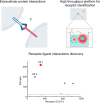A Platform for Extracellular Interactome Discovery Identifies Novel Functional Binding Partners for the Immune Receptors B7-H3/CD276 and PVR/CD155
- PMID: 31308249
- PMCID: PMC6823854
- DOI: 10.1074/mcp.TIR119.001433
A Platform for Extracellular Interactome Discovery Identifies Novel Functional Binding Partners for the Immune Receptors B7-H3/CD276 and PVR/CD155
Abstract
Receptors expressed on the plasma membrane and their interacting partners critically regulate cellular communication during homeostasis and disease, and as such represent main therapeutic targets. Despite its importance for drug development, receptor-ligand proteomics has remained a daunting field, in part because of the challenges associated to the study of membrane-expressed proteins. Here, to enable sensitive detection of receptor-ligand interactions in high throughput, we implement a new platform, the Conditioned Media AlphaScreen, for interrogation of a library consisting of most single transmembrane human proteins. Using this method to study key immune receptors, we identify and further validate the interleukin receptor IL20RA as the first binding partner for the checkpoint inhibitor B7-H3. Further, KIR2DL5, a natural killer cell protein that had remained orphan, is uncovered as a functional binding partner for the poliovirus receptor (PVR). This interaction is characterized using orthogonal assays, which demonstrate that PVR specifically engages KIR2DL5 on natural killer cells leading to inhibition of cytotoxicity. Altogether, these results reveal unappreciated links between protein families that may importantly influence receptor-driven functions during disease. Applicable to any target of interest, this technology represents a versatile and powerful approach for elucidation of receptor-ligand interactomes, which is essential to understand basic aspects of the biology of the plasma membrane proteins and ultimately inform the development of novel therapeutic strategies.
Keywords: assay development; automation; cancer therapeutics; cell-cell interactions; protein-protein interactions; secretome.
© 2019 Husain et al.
Figures








Similar articles
-
A membrane protein display platform for receptor interactome discovery.Proc Natl Acad Sci U S A. 2021 Sep 28;118(39):e2025451118. doi: 10.1073/pnas.2025451118. Proc Natl Acad Sci U S A. 2021. PMID: 34531301 Free PMC article.
-
Analysis of the receptor-ligand interactions in the natural killer-mediated lysis of freshly isolated myeloid or lymphoblastic leukemias: evidence for the involvement of the Poliovirus receptor (CD155) and Nectin-2 (CD112).Blood. 2005 Mar 1;105(5):2066-73. doi: 10.1182/blood-2004-09-3548. Epub 2004 Nov 9. Blood. 2005. PMID: 15536144
-
HIV-1 Nef-mediated downregulation of CD155 results in viral restriction by KIR2DL5+ NK cells.PLoS Pathog. 2022 Jun 24;18(6):e1010572. doi: 10.1371/journal.ppat.1010572. eCollection 2022 Jun. PLoS Pathog. 2022. PMID: 35749424 Free PMC article.
-
Poliovirus receptor (PVR)-like protein cosignaling network: new opportunities for cancer immunotherapy.J Exp Clin Cancer Res. 2021 Aug 25;40(1):267. doi: 10.1186/s13046-021-02068-5. J Exp Clin Cancer Res. 2021. PMID: 34433460 Free PMC article. Review.
-
Targeting PVR (CD155) and its receptors in anti-tumor therapy.Cell Mol Immunol. 2019 Jan;16(1):40-52. doi: 10.1038/s41423-018-0168-y. Epub 2018 Oct 1. Cell Mol Immunol. 2019. PMID: 30275538 Free PMC article. Review.
Cited by
-
TIGIT blockade enhances NK cell activity against autologous HIV-1-infected CD4+ T cells.Clin Transl Immunology. 2021 Oct 19;10(10):e1348. doi: 10.1002/cti2.1348. eCollection 2021. Clin Transl Immunology. 2021. PMID: 34707863 Free PMC article.
-
B7 homolog 3 in pancreatic cancer.World J Gastroenterol. 2024 Aug 21;30(31):3654-3667. doi: 10.3748/wjg.v30.i31.3654. World J Gastroenterol. 2024. PMID: 39193002 Free PMC article. Review.
-
New frontiers in immune checkpoint B7-H3 (CD276) research and drug development.Mol Cancer. 2023 Mar 2;22(1):43. doi: 10.1186/s12943-023-01751-9. Mol Cancer. 2023. PMID: 36859240 Free PMC article. Review.
-
Discovery of Carbonic Anhydrase 9 as a Novel CLEC2 Ligand in a Cellular Interactome Screen.Cells. 2024 Dec 17;13(24):2083. doi: 10.3390/cells13242083. Cells. 2024. PMID: 39768175 Free PMC article.
-
Revealing the mechanisms and therapeutic potential of immune checkpoint proteins across diverse protein families.Front Immunol. 2025 Apr 28;16:1499663. doi: 10.3389/fimmu.2025.1499663. eCollection 2025. Front Immunol. 2025. PMID: 40356928 Free PMC article. Review.
References
-
- Hopkins A. L., and Groom C. R. (2002) The druggable genome. Nat. Rev. Drug Discov. 1, 727–730 - PubMed
-
- Overington J. P., Al-Lazikani B., and Hopkins A. L. (2006) How many drug targets are there? Nat. Rev. Drug Discov. 5, 993–996 - PubMed
-
- Wright G. J., Martin S., Bushell K. M., and Sollner C. (2010) High-throughput identification of transient extracellular protein interactions. Biochem. Soc. Trans. 38, 919–922 - PubMed
MeSH terms
Substances
LinkOut - more resources
Full Text Sources
Other Literature Sources
Research Materials

